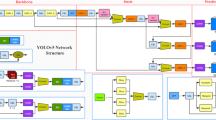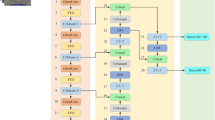Abstract
The crowding in bus is an important factor affecting passenger satisfaction and bus dispatching level. However, how to use video images to detect crowding accurately is a difficult problem. In this paper, firstly, an image sample library is established based on the evaluation standard of crowding in bus, which contains 16346 sample images. Then, Local Binary Pattern (LBP) and Gray Level Co-occurrence Matrix (GLCM) are used to extract the texture features of the image in bus. Then, a rough classification method of crowding based on Support Vector Machine (SVM) is proposed. At the same time, in order to improve the accuracy of rough classification of crowding, the optimization effects of grid search algorithm, particle swarm optimization algorithm and genetic algorithm on SVM parameters are compared. The results show that the optimization effect of genetic algorithm is the best, and the accuracy rate is 93.20%. Finally, for the problem that the SVM method is not ideal in the fine classification of crowding, this paper proposes a new method based on ResNet. SGD, Adadelta and Adam are selected to optimize the parameters of ResNet model. The accuracy of the optimal Adam algorithm reaches 96.22%, which effectively solves the problem of the fine classification of crowding in bus.














Similar content being viewed by others
References
Azencott R, Wang JP, Younes L (1997) Texture classification using windowed Fourier filters[J]. IEEE Trans Pattern Anal Mach Intell 19(2):148–153
Bai H, Liu H, Ni H et al (2012) Bus fare classification with genetic algorithm[J]. Transp Syst Eng Inform 12(1):180–184
Kittelson & Assoc, Inc., Parsons Brinckerhoff, Inc., KFH Group, Inc., Texam A&M Transportation Institute, & Arup (2013) Transit capacity and quality of service manual. Third Edition [M]. Transportation Research Board
Chow TWS, Cho SY (2002) Industrial neural vision system for underground railway station platform surveillance[C]. Adv Eng Inform 16(1):73–83
Chow TWS, Yam JYF, Cho SY (1999) Fast training algorithm for feedforward neural networks: Application to crowd estimation at underground stations[J]. Artif Intell Eng 13(3):301–307
Comer ML, Delp EJ (1999) Segmentation of textured images using a multiresolution Gaussian autoregressive model[J]. IEEE Trans Image Process 8(3):408–420
Cortes C, Vapnik V (1995) Support-vector networks[J]. Mach Learn 20(3):273–297
Cover TM, Hart PE (1967) Nearest neighbor pattern classification[J]. IEEE Trans Inf Theory 13(1):21–27
Davies AC, Yin JH, Velastin SA (1995) Crowd monitoring using image processing[J]. Electron Commun Eng J 7(1):37–47
Haralick RM, Shanmugam K (1973) Texture features for image classification[J]. IEEE Trans Syst Man Cybern 3(6):610–621
He K, Zhang X, Ren S et al (2016) Deep residual learning for image recognition[C]. Conference on Computer Vision and Pattern Recognition (CVPR), Las Vegas, pp 770-778
Huang L, Wu N, Wang X et al (2019) Research on classroom face recognition based on feature vector extraction and SVM classifier[J]. Instrum Cust 26(2):15–17
Lameski P, Zdravevski E, Mingov R et al (2015) SVM Parameter Tuning with Grid Search and Its Impact on Reduction of Model Over-fitting[M]. Rough Sets, Fuzzy Sets, Data Mining, and Granular Computing. Springer International Publishing
Li Z (2020) Research on bus congestion detection based on video image [D]. Beijing Jiaotong University, Beijing
Li Z, Han J, Zhao X et al (2015) Comparison of drunk driving recognizing methods based on KNN and SVM [J]. J Transp Syst Eng Inf Technol 15(5):246–251
Li B, Han X, Dongmei W (2018) Real-time crowd density estimation based on convolutional neural networks [J]. J Graph 39(4):728–734
Marana AN, Velastin SA, Costa LF et al (1997) Estimation of crowd density using image processing[C]. IEE Colloquium on Image Processing for Security Applications (Digest No: 1997/074), London, pp 11/1-11/8
Marana AN, Costa LF, Lotufo RA et al (1998) On the efficacy of texture analysis for crowd monitoring[C]. International Symposium on Computer Graphics. IEEE Computer Society, pp 354-361.
Ojala T, Pietikainen M, Maenpaa T (2002) Multiresolution gray-scale and rotation invariant texture classification with local binary patterns[J]. IEEE Trans Pattern Anal Mach Intell 24(7):971–987
Sam DB, Surya S, Babu R V (2017) Switching Convolutional Neural Network for Crowd Counting[C]. Conference on Computer Vision and Pattern Recognition (CVPR), Honolulu, pp 4031-4039
Shi X, Huang Q, Chang J et al (2015) Optimal parameters of the SVM for temperature prediction[J]. Proc Int Assoc Hydrol Sci 368:162–167
Simard M, Saatchi SS, De Grandi G (2000) The use of decision tree and multiscale texture for classification of JERS-1 SAR data over tropical forest[J]. IEEE Trans Geosci Remote Sens 38(5):2310–2321
Sindagi V A, Patel V M (2017) Generating High-Quality Crowd Density Maps using Contextual Pyramid CNNs[C]. International Conference on Computer Vision (ICCV), Venice, pp 1879-1888
Tang Y, Lu W, Cheng C et al (2019) Illumination Calculation Method Based on Adam Algorithm and Neural Network[J]. China Illum Eng J 30(2):50–54
Wang Y (2013) Research on population density estimation algorithm based on gray symbiosis matrix [D]. Xi’an University of Science and Technology, Shaanxi
Wu M, Huang H, Wang X (2018) Robot welding path planning based on improved ant colony algorithm[J]. Trans J China Weld Inst 39(10):113–118
Zhang X, Guo Y (2009) Optimization of SVM Parameters Based on PSO Algorithm[C]. International Conference on Natural Computation. IEEE Press, pp 536-539
Zhang C, Li H, Wang X, et al (2015) Cross-scene crowd counting via deep convolutional neural networks[C]. Conference on Computer Vision and Pattern Recognition (CVPR), Boston, pp 833-841
Zhang Y, Zhou D, Chen S et al (2016) Single-Image Crowd Counting via Multi-Column Convolutional Neural Network[C]. Conference on Computer Vision and Pattern Recognition (CVPR), Las Vegas, pp 589-597
Zhang Y, Lin H, Guan Y et al (2019) GAN image super-resolution reconstruction model with improved residual block and adversarial loss[J]. J Harbin Inst Technol 51(11):128–137
Zhao J, Wang X (2019) Vehicle-logo recognition based on modified HU invariant moments and SVM[J]. Multimed Tools Appl 78(1):75–97
Zhao J, Wu H, Chen L (2017) Road Surface State Recognition Based on SVM Optimization and Image Segmentation Processing[J]. J Adv Transp 2017:1–21
Acknowledgement
This work is supported by the National Key R&D Program of China (2019YFB1600200), National Natural Science Foundation of China (71871011, 71890972/71890970, 71621001), and the first batch of science and technology projects of Jingde Expressway (JD-202014).
Author information
Authors and Affiliations
Corresponding author
Additional information
Publisher’s note
Springer Nature remains neutral with regard to jurisdictional claims in published maps and institutional affiliations.
Rights and permissions
About this article
Cite this article
Zhao, J., Lei, W., Li, Z. et al. Detection of crowdedness in bus compartments based on ResNet algorithm and video images. Multimed Tools Appl 81, 4753–4780 (2022). https://doi.org/10.1007/s11042-021-11008-6
Received:
Revised:
Accepted:
Published:
Issue Date:
DOI: https://doi.org/10.1007/s11042-021-11008-6




